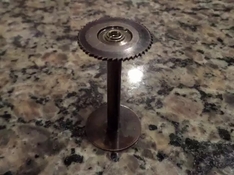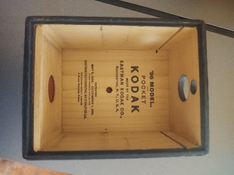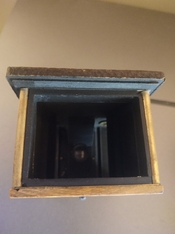You may very well be correct, but that only leaves 1/16 of an inch on each side of the image, a tolerance they might not mess with in 1895. There has got to be some official Kodak details somewhere, just like there is for the stuff commonly referred to as 35mm film -- something that Eastman originally produced at 1 3/8".
W.K.L. Dickson, in an article that he wrote for the SMPTE Journal in 1933, described his central role in the development of Edison's Kinetoscope and Kinetograph. It gives us a look at how 35mm film and still cameras evolved. Dickson was a researcher for Edison, and was put onto the Motion Picture project in 1887. By 1888, he was able to make some sort of motion pictures using multipe rows of tiny shots on Carbutt's stiff sensitized celluloid.
Coincidentally, in late 1888, George Eastman's company gave a private demonstration of a new product at the New York Camera Club, which Dickson happened to attend. He immediately opened discussions with the Eastman company, and was soon dealing directly with George, who supplied them with many samples of short lengths of Eastman's new flexible film. As Dickson worked with the stuff, he came back to Eastman requesting finer grain, greater sensitivity of emulsion, and greater flexibility of the base. He worked very closely with Eastman to refine the product right from the beginning. Dickson's account gives the impression that the flexible film we know today was developed with a lot of input from the Edison experimenters to meet motion picture needs. He states that he received his first 50-foot rolls of film from Eastman in the spring of 1889, and that:
"All these samples and experiments were made exclusively for us by Mr. Eastman, who took an ever-increasing interest in what we were doing."
The Edison people had to cut and sprocket the stuff themselves, and it is unclear what the exact width these first 50 foot rolls were. Dickson goes on:
"At the end of the year 1889, I increased the width of the picture from 1/2 inch to 3/4. The actual width of the film was 1 3/8 inches to allow for perforations now punched on both edges, 4 holes to the phase or picture, which perforations were a shade smaller than those now in use. This standardized film size of 1889 has remained, with only minor variation, unaltered to date."





 . I’m flattered by your confidence in my computer abilities, but I’m an old film guy only. The photo I copied from a link (which I also tried and failed to post) is on my iphone. If it just takes a few words, would you mind replying or PMming me with a couple of hints how to do that? Sorry …
. I’m flattered by your confidence in my computer abilities, but I’m an old film guy only. The photo I copied from a link (which I also tried and failed to post) is on my iphone. If it just takes a few words, would you mind replying or PMming me with a couple of hints how to do that? Sorry …





